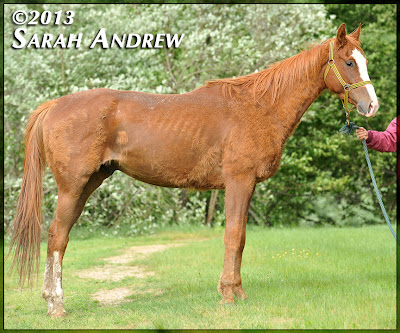--
Brian DiDonato
1. Frac Daddy -
Pro: These connections did dead-heat for the win in last year’s Travers with impossible-to-have Golden Ticket, and conditioner Ken McPeek did upset the 2002 renewal of this with 70-1 shot Sarava.
Con: Where are his good races? Hasn’t come close to running back to maiden romp in November and his second in the Arkansas Derby was a total clunk up job.
Verdict: Not seeing it.
2.
Freedom Child -
Pro: His break-out romp in the Peter Pan last time was very impressive and he may be peaking at the right time. Has the ever-dangerous fresh face angle on his side and has looked good in the mornings.
Con: The Peter Pan was run over a sloppy track, and while similar conditions are very possible Saturday, it’s probably best to look at that performance with at least a little skepticism. Pace may pose a serious problem, as on pace figures he appears likely to get himself in trouble early.
Verdict: Wouldn’t toss completely, as he clearly has some talent and upside, but will only use defensively as the pace appears like it might do him in.
3.
Overanalyze -
Pro: Does have two graded stakes wins at 1 1/8 miles, and one race that’s close to fast enough. He may have had the sneakiest trip of anyone in the Derby while finishing 11th--was shuffled back to last on the far turn, but made a nice run in the lane despite additional traffic trouble.
Con: His pedigree certainly doesn’t scream 1 1/2 miles, but another son of Dixie Union (who I completely tossed, partially because of his pedigree) did win the Belmont last year.
Verdict: Have never been a fan of his at all and don’t think he’s anything special, but he fits the profile of a horse who could make some noise here and I’m willing to excuse his very obvious pedigree concerns because of past success at nine furlongs--especially at double-digit odds.
4.
Giant Finish -
Pro: He’d be a nice Big Apple Triple candidate.
Con: He already missed the first leg of the Big Apple Triple last Saturday.
Verdict: No.
5.
Orb -
Pro: The positives are pretty obvious for him--he should get pace again, he might get slop again, and he figures to love the distance.
Con: The jury was still out on him a bit going into the Derby, and while most of us (myself included) were willing to buy the hype after that race, it seems we were much too forgiving of the dream pace set-up he and the other on-the-board finishers enjoyed. Now can you really take him as a favorite off that mediocre (at best) effort in the Preakness?
Verdict: Think he’ll be an underlay, but he’s going to get very similar circumstances to those that helped him garner all the hype. Certainly can’t toss.
6.
Incognito -
Pro: Obviously bred for this, being by A.P. Indy (Belmont winner and sire of a Belmont winner) out of Octave, winner of the local GI CCA Oaks at 10 furlongs. Overcame a world of trouble to beat older (weak) optional claiming foes two back, and was simply never put in a position to win last time in the Peter Pan. It was really a perplexing ride--he was dragged far out of it and never allowed to run until it was much too late. The grey did fly home, however, and galloped out in front. A rider change can’t hurt.
Con: Somewhat immature and may find his own trouble, plus he does need to run much faster. Morning impressions have been a bit negative.
Verdict: I’m playing him--he’s super dirtied up trip wise and has the best pedigree in the race for 1 1/2 miles.
7.
Oxbow -
Pro: He finally put it all together last time, and earned a 106 Beyer Speed Figure vs. Orb’s 104 for the Derby. His stout pedigree is well-documented.
Con: I know it’s been fashionable to call the pace Oxbow set in the Preakness “fair” rather than “slow,” but I’m not so sure--the Moss Pace Figures have the opening half five points below par. If that’s fair, it’s definitely on the slow side of fair. And isn’t the pace guaranteed to be faster this time? Can’t see Stevens taking back considering how well the horse ran when sent.
Verdict: A classic “last time was the time” horse.
8.
Midnight Taboo -
Pro: Probably has upside considering how lightly raced he is. Dam is a half to the dam of Belmont winner and Horse of the Year Point Given.
Con: May not have the foundation to go 12 furlongs just yet. Did have some traffic trouble when second in allowance company last time, but didn’t really seem to have the punch to get himself out of trouble.
Verdict: Connections giving off a vibe that he’s running just to run, so hard to have much faith in him.
9.
Revolutionary -
Pro: Hasn’t been off the board in his seven-race career, and handled the slop fine last time in the Derby. His sire (War Pass) wouldn’t have gotten the Belmont distance, but he’s out of an Alabama winner and gets plenty of stamina from his dam’s side.
Con: Was clearly third best in the Derby--covered less ground than both Orb and Golden Soul, and was simply out-kicked by a 34-1 shot. Hasn’t looked spectacular in the mornings.
Verdict: Called him “the most likely winner” of the Derby and he ran ok, but now I’m tossing. Go figure.
10.
Will Take Charge -
Pro: Everyone saw the trouble he had in the Derby--was moving right with Orb before getting stopped by Verrazano. Is a very large horse with a grinding style that is conducive to Big Sandy and this race. Going third off the lay-off now after being trained up to the Derby.
Con: Never did any running in the Preakness--just never really seemed to get going while well off the pace.
Verdict: Using him again--this might be the race where he shows up at a huge price.
11.
Vyjack -
Pro: He’s a really nice horse up to about 1 1/16 miles. Was very wide in the Derby.
Con: Has given zero indication that he wants to go this far.
Verdict: Probably would win the Woody Stephens, but this is five furlongs farther.
12.
Palace Malice -
Pro: Obviously, you can’t take his Derby at face value considering the insane pace he set.
Con: While he’s bred to run long, has always struck me as a horse with serious distance limitations. Everyone’s acting like he’s going to turn into Silky Sullivan losing the blinkers, but I’ll be surprised if he’s not again close to the pace, which figures to be legitimate.
Verdict: He’ll ultimately prove better going much shorter than this--possibly on grass.
13.
Unlimited Budget -
Pro: Has never run a bad race, and her only loss last time in the Oaks came when she was close to a quick pace.
Con: Still, runner-up Beholder was closer to that pace, and Unlimited Budget just didn’t show much kick. Not sure how much stamina she gets from the bottom half of her pedigree. Don’t buy the notion that the colts and fillies this year are evenly matched.
Verdict: Nice horse, but probably the underlay of the race on the morning line at 8-1. Not using.
14.
Golden Soul -
Pro: Gave him a bit of a chance to clunk up and hit the board in the Derby, and he did. Should appreciate even more distance and might get identical circumstances here.
Con: Did have a lot go his way in the Derby, and hard to take him at a much shorter price than he was last time.
Verdict: No real reason he can’t hit the board again as this may have the makings of a Derby repeat, but expect him to find at least one better.
How I’m playing: Would like to be alive to as many as possible in here as this has chaos race written all over it. In the actual race, I’ll bet
Incognito to win at what figures to be 20-1+. Will also play an exacta box of Incognito,
Overanalyze and
Will Take Charge. Will probably work in Orb and Golden Soul as well, but the Belmont’s a race to swing for the fences in, so I’ll be looking for a nice $800+ pay-out for every $2.






















